somuchscience
14K posts
I am an ornithologist, evolutionist, natural historian, museum curator, educator, and Ph.D. student. I firmly believe that we are all lifelong learners and no one should ever stop exploring. Stay curious! "Happy is the man whose lot it is to know the secrets of the Earth." -Euripides
Don't wanna be here? Send us removal request.
Video
tumblr
Every time I go downstairs to the laundry room, this pigeon tries to seduce me.
534K notes
·
View notes
Video
youtube
Original description: “Check out the Golden-tailed Gecko's (Strophurus taenicauda) threat display in slow motion. When under attack this Gecko has an incredible way of deterring predators. They open their mouths to show a blacky blue lining as a warning to stay back, just as the black mamba does. As you can see the beautiful golden tail is lifted like a scorpion and is able to squirt out a foul smelling and sticky liquid if the predator comes any closer, making this one of the coolest geckos on the planet!”
@markscherz, or other gecko enthusiasts, please explain.
What are they squirting?! Are they glands?? Any idea if they’re homologous to the epidermal glands in other squamates or maybe scent glands in other geckos? Since when did geckos have these kinds of anti-predator defenses???
31 notes
·
View notes
Photo



Manta rays spend much of their time leisurely cruising through the water with their meter-wide mouths open. As they swim, they filter plankton, which makes up most of their diet, from the water. And they do so without ever clogging.
The inside of the manta’s mouth is lined with gill rakers (upper right), a series of comb-like teeth. When flow hits the leading edge of these (bottom), it creates a vortex that accelerates any particles caught in the flow. They essentially ricochet along the top of the gill rakers, getting led straight into the manta’s digestive system - while excess water gets deflected between the gill rakers and back out the manta’s gills. To drive this, all the manta has to do is swim; with the right flow speed, the shape of the gill rakers handles all the filtration with no additional effort. (Image credit: manta ray - G. Flood; gill rakers - M. Paig-Tran; flow vis - R. Divi et al., source; research credit: M. Paig-Tran et al.; via The Atlantic; submitted by Kam-Yung Soh)
412 notes
·
View notes
Photo
Remember that one time I chased lizards in Tanzania that looked like they were colored by 6-year-olds with crayons?



Three species of Agama from East Africa
Red-headed Rock Agama (Agama agama) Oldupai Gorge, Tanzania January 16, 2015
Blue-headed Tree Agama (Acanthocercus atricollis) Ngorongoro Crater Conservation Area, Tanzania January 15, 2015 Mwanza Flat-headed Agama (Agama mwanzae) Serengeti National Park, Tanzania January 16, 2015
All photos copyright of Robert Niese. See more original animal photos here.
147 notes
·
View notes
Photo
Pangolins, all 8 species, coming soon to a Faunal Frontier near you!
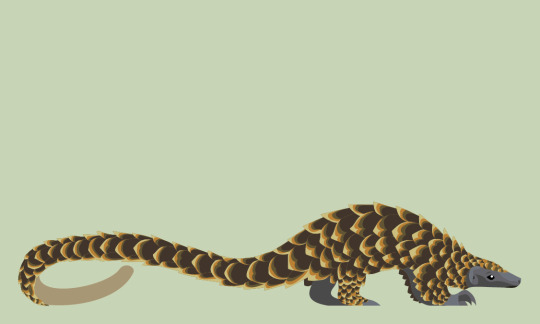
Phataginus tetradactyla - Black-Bellied Pangolin
230 notes
·
View notes
Photo
Is that a dirt floor or a spore floor???

Reishi farmin’
79K notes
·
View notes
Photo

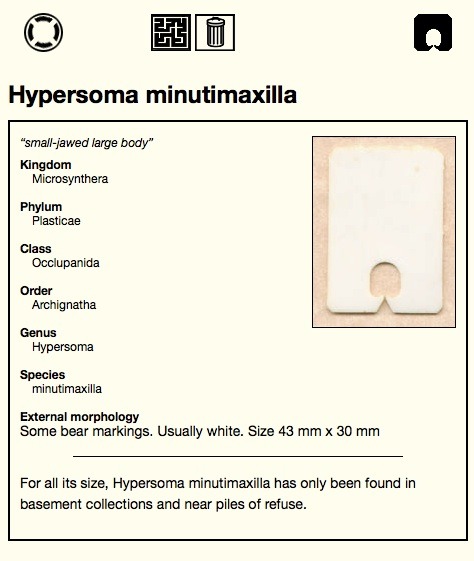
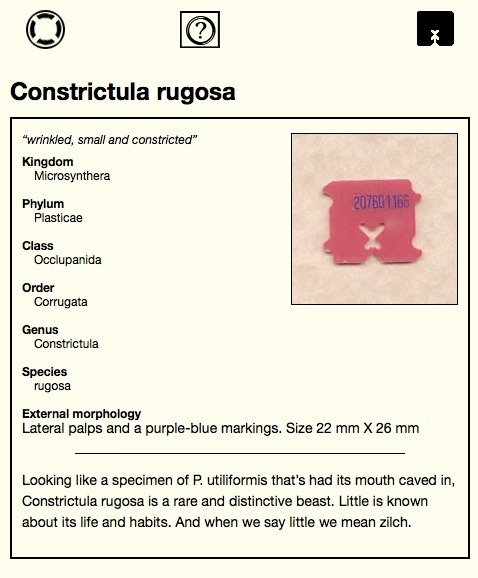

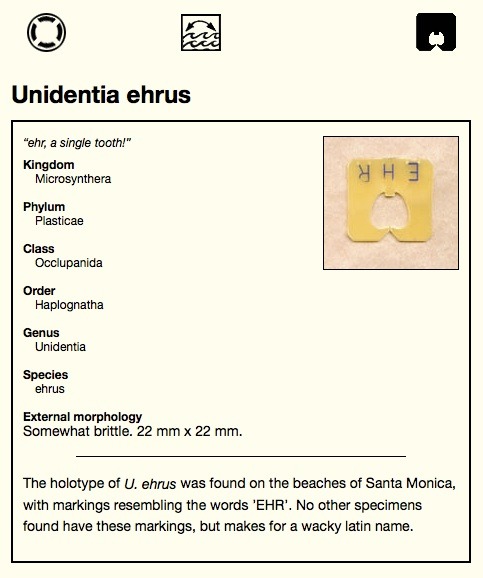
You know those little things that keep bread bags closed? Well, the internet would like to tell you about them. If you’re not doing anything too important right now, I think you should visit HORG (that’s the Holotypic Occlupanid Research Group) and explore a beautiful, obsessive, hilarious taxonomy of occlupanids.
(ht Metafilter)
25K notes
·
View notes
Photo





Light Painting Machine
Project from Josh Sheldon showcases his light painting animation set-up, translating scenes created in 3D software Blender that are replicated with robotic controlled camera and LED:
youtube
I made this robot to make light painting animations. Each of the animations I made took between 4 and 12 hours to shoot, one frame at a time. Each frame is 1-3 long exposure photographs of the machine performing the light painting.
More Here
642 notes
·
View notes
Photo







Summer brings with it lots of great sports, and whether you love riding a bike, sailing a boat, or just hanging out at the pool, our latest FYFD/JFM video has something for you. Want even more sports physics? Check out the Olympic series we did for the London and Rio games. And if you’re looking for more of the latest fluids research, don’t miss the rest of our video series. (Video and image credit: N. Sharp and T. Crawford)
youtube
133 notes
·
View notes
Photo

A boatload of scientists + 30 days at sea = New discovery!
Turns out the “White Shark Café,” an expanse of open water in the Pacific, lives up to its name, offering a smorgasbord of scrumptious snacks for white sharks.
Check out our blog post about The White Shark Voyage for more info.
📷: Stanford University
301 notes
·
View notes
Photo
SO MANY SPOTS

Pardofelis marmorata - Marbled Cat
472 notes
·
View notes
Photo
Is this the one that evolves into a Alomomola?

The colorful Opah, or Moonfish, can reach 2 m (7 ft.) in length and weigh up to 270 kg (600 lbs).
It lives throughout the world’s oceans at depths of 100 to 400 m (330 to 1,300 ft), where it hunts squid.
It’s also the first fish known to warm its entire body, including the heart. How?
Heat that’s generated with its swim muscles is retained thanks a system of blood vessels that minimizes heat loss via the gills and an insulating layer of fat, allowing the opah to distribute warm blood throughout its body—and giving this fish an edge when it travels through colder, deeper waters.
Photograph: Ralph Pace (NOAA Fisheries)
via: American Museum of Natural History
187 notes
·
View notes
Photo
FALSE! This is an excellent example of a “just-so story.” Most Carnivorans are capable of a direct register walk (especially Canids and Felids) and it almost entirely depends on the speed at which the animal desires to locomote. Very slow walks are “understep” where the hind-foot falls behind the print left by the fore-foot. The faster the animal moves, the farther forward the hind-foot print falls in relation to the fore-foot print. Above a certain speed (still a walk) the hind-foot begins to fall in front of the print left by the fore-foot (an “overstep” walk).
There are, however, some unique circumstances when an animal will force a direct-register walk. Those are usually related to the susbtrate. In deep snow, mud, or sand, some animals force a direct register walk presumably to minimize effort in traversing these energetically expensive terrains (though this hasn’t been tested). There is also anecdotal evidence that Felids will force a direct register walk while stalking prey, presumably to minimize the potential noise created by their footfalls (this too has never been tested).

71K notes
·
View notes
Photo
TLDR: The introduction of St Johnswort beetles to California in the 1940s was the world’s first nationally sponsored introduction of a biological control agent. The endeavor was so successful that the beetles have their own national monument thanking them for their service to the country.
Harry Scott Smith, a professor of agricultural sciences at the University of California - Riverside, coined the term “biological control” in 1919 and was a pioneer in the field until his death in 1957. In 1922, he proposed controlling the spread and promoting the eradication of the noxious weed St. Johnswort (Hypericum perforatum) by introducing its natural predators, European leaf beetles in the genus Chrysolina. Scientists and administrators laughed at the idea at the time, calling it harebrained and reckless.
It wasn’t until 1944 that Smith finally received the support and permission of the US Department of Agriculture to proceed with his unusual plan. In 1946, after extensive starvation tests on quarantined beetles (to make sure they wouldn’t start eating non-target species), the beetles were released in Humboldt County, CA. Within ten years of their release, populations of the once infamous Klamath weed plummeted by 99%. Where once the weed had been so abundant that farmers, ranchers, and wool-growers feared they would lose their livelihoods to the pest, it is now considered a rare roadside weed. A similar eradication occurred in Oregon, Washington, Idaho, Montana, and British Columbia, and, to this day, St. Johnswort is remains a fairly uncommon weed here in the Pacific Northwest.
The introduction of Chrysolina quadrigemina was such a huge, international success that the beetle has its own national monument thanking it and Dr. Smith for saving the Klamath rangelands.
Sources: P. DeBach and D. Rosen. 1991. Biological Control by Natural Enemies



These might look like berries at first glance, but these St. Johnswort beetles [Chrysolina hyperici] are no friend to the plant on which they sit. These beetles were introduced to the United States and Australia in the mid 20th century in an attempt to control the spread of the St. Johns wort weed. Images by Joyce Gross.
129 notes
·
View notes
Photo
This is so cool!!! Can’t wait to hear more about what we discover at the Café!
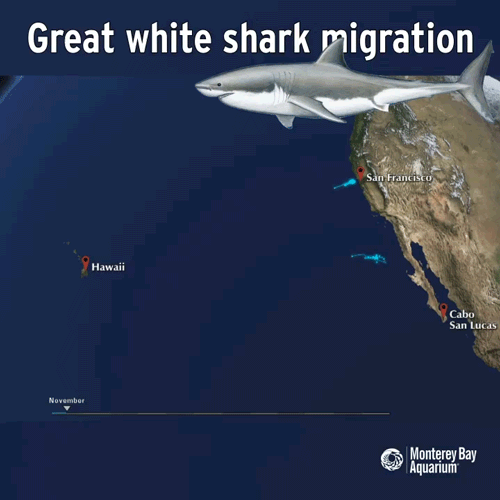
Every year like clockwork, sharks make reservations at the White Shark Café, a mysterious spot halfway between Mexico and Hawaii—no one knows why! But for the first time ever, a team of humans is tagging along. Stay tuned to see what our researchers and their partners learn on the White Shark Voyage with Schmidt Ocean Institute.
2K notes
·
View notes
Text
A couple quick notes from a biologist:
1) Sexually selected traits are not necessarily "sexy" traits. For example, male garter snakes have a large spine at the base of their hemipenises that snags onto the female's cloaca during copulation. This is a sexually selected trait that is associated with increased copulation duration and larger copulatory plugs (both of which increase a male's sexual success), but females likely do not find it "sexy" (Friesen et al. 2013). 2) Horns and other weapons are not necessarily sexually selected. In horned lizards (Phrynosoma), for example, horns are the result of natural selection for defense against predatory birds (Young et al. 2004). Weapons that are not sexually dimorphic are usually considered to be the result of stronger natural selection than sexual selection. 3) Counter-shading is not necessarily an adaptation for camouflage. A dark dorsum may be an adaptation for resistance to UV radiation or mechanical abrasion (Kiltie 1988). Alternatively, if pigments are expensive to produce, animals may simply “cut costs” by only distributing pigments on half of the body (Caro 2005). Lastly, the Agouti gene, which controls counter-shading across most vertebrates, also controls many other aspects of pigment patterning (i.e. it is highly pleiotropic) which could make counter-shading a byproduct of selection at other loci on the gene (Manceau et al. 2011).
Borealopelta markmitchelli
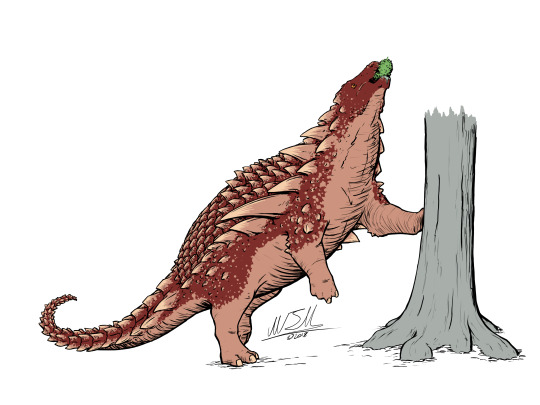
By Maya Jade McCallum, on @hauntedmech
PLEASE SUPPORT US ON PATREON. EACH and EVERY DONATION helps to keep this blog running! Any amount, even ONE DOLLAR is APPRECIATED! IF YOU ENJOY THIS CONTENT, please CONSIDER DONATING!
Name: Borealopelta markmitchelli
Name Meaning: Northern Shield
First Described; 2017
Described By: Brown et al.
Classification: Dinosauria, Ornithischia, Genasauria, Thyreophora, Eurypoda, Ankylosauria, Nodosauridae, Nodosaurinae
Borealopelta is an exciting recently described Nodosaurid that is remarkable because it was essentially mummified - the osteoderms, skin, and even color were preserved in three-dimensions. The fossil was so heavy and so buried in its environment that it actually broke under its own weight, but luckily the pieces were kept and transported successfully. Borealopelta was found in the Clearwater Formation of Alberta, Canada, living about 110 to 112 million years ago, in the Albian age of the Early Cretaceous. Borealopelta had died on the shore of the Western Interior Seaway and was washed out to sea after death, buried on the ocean floor quickly (topside - down) with very little distortion, making the fossil look like how the dinosaur looked when it was alive.

Photo by Machairo, CC BY-SA 4.0
Borealopelta shows the positioning of armor when the animal was alive, a unique thing for an Ankylosaur which usually aren’t preserved articulated enough to know with this level of precision. In addition to that, the osteoderms had keratin sheaths over them, indicating the spikes and other structures were even longer in life than they were in typical ankylosaur fossils. In fact, this probably applies to most armor structures in dinosaurs, indicating that things like Triceratops had amazingly long horns. Since these structures - in both groups of dinosaurs - were primarily sexually selected ones (meaning, they got so ridiculous because other dinosaurs found them sexy), the sheathes wouldn’t have been really used for defense very much, though they would have been capable of doing so.
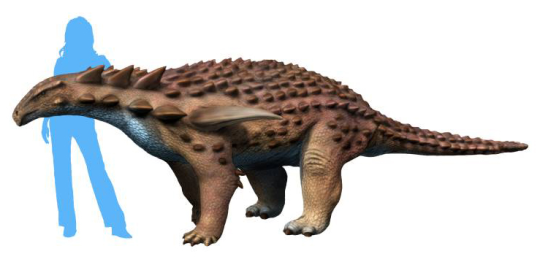
By Nobu Tamura, CC BY-SA 4.0
Borealopelta was preserved with pigmentation - a structure usually only found in things like small birdie dinosaurs (with Psittacosaurus as a notable excpetion) - indicating this dinosaur would have been reddish-brown colored, with countershading for camouflage in its environment, though it’s difficult to tell what sort of environment that would have been since the animal was washed out to sea. The armor on its back that wasn’t so extensively keratinized (ie, not the big shoulder spikes, but the bumpy osteoderms all over) probably would have allowed it to defend itself, since the camouflage indicates it would have been hunted by prey (why hide if nothing is chasing you?). This dinosaur was recently discovered, and hopefully more research of it will show us even more about Borealopelta and other Ankylosaurs.
Source:
https://en.wikipedia.org/wiki/Borealopelta
871 notes
·
View notes
Video
youtube
The Faunal Frontier Draws: Hydrurga leptonyx - Leopard Seal
You may have heard me say before that I’ll be doing drawing videos. Well here’s what I mean! Here’s a closer look at how I drew the Leopard Seal, Hydrurga leptonyx, which will be posted tomorrow!
23 notes
·
View notes